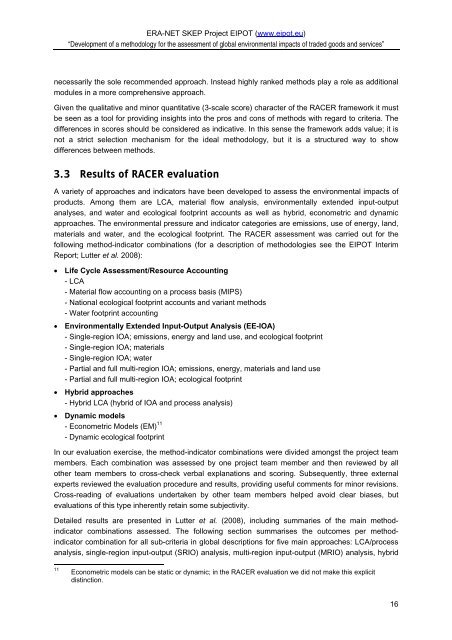EIPOT Final Project Report - Stockholm Environment Institute
EIPOT Final Project Report - Stockholm Environment Institute
EIPOT Final Project Report - Stockholm Environment Institute
You also want an ePaper? Increase the reach of your titles
YUMPU automatically turns print PDFs into web optimized ePapers that Google loves.
ERA-NET SKEP <strong>Project</strong> <strong>EIPOT</strong> (www.eipot.eu)<br />
“Development of a methodology for the assessment of global environmental impacts of traded goods and services”<br />
necessarily the sole recommended approach. Instead highly ranked methods play a role as additional<br />
modules in a more comprehensive approach.<br />
Given the qualitative and minor quantitative (3-scale score) character of the RACER framework it must<br />
be seen as a tool for providing insights into the pros and cons of methods with regard to criteria. The<br />
differences in scores should be considered as indicative. In this sense the framework adds value; it is<br />
not a strict selection mechanism for the ideal methodology, but it is a structured way to show<br />
differences between methods.<br />
3.3 Results of RACER evaluation<br />
A variety of approaches and indicators have been developed to assess the environmental impacts of<br />
products. Among them are LCA, material flow analysis, environmentally extended input-output<br />
analyses, and water and ecological footprint accounts as well as hybrid, econometric and dynamic<br />
approaches. The environmental pressure and indicator categories are emissions, use of energy, land,<br />
materials and water, and the ecological footprint. The RACER assessment was carried out for the<br />
following method-indicator combinations (for a description of methodologies see the <strong>EIPOT</strong> Interim<br />
<strong>Report</strong>; Lutter et al. 2008):<br />
• Life Cycle Assessment/Resource Accounting<br />
- LCA<br />
- Material flow accounting on a process basis (MIPS)<br />
- National ecological footprint accounts and variant methods<br />
- Water footprint accounting<br />
• <strong>Environment</strong>ally Extended Input-Output Analysis (EE-IOA)<br />
- Single-region IOA; emissions, energy and land use, and ecological footprint<br />
- Single-region IOA; materials<br />
- Single-region IOA; water<br />
- Partial and full multi-region IOA; emissions, energy, materials and land use<br />
- Partial and full multi-region IOA; ecological footprint<br />
• Hybrid approaches<br />
- Hybrid LCA (hybrid of IOA and process analysis)<br />
• Dynamic models<br />
- Econometric Models (EM) 11<br />
- Dynamic ecological footprint<br />
In our evaluation exercise, the method-indicator combinations were divided amongst the project team<br />
members. Each combination was assessed by one project team member and then reviewed by all<br />
other team members to cross-check verbal explanations and scoring. Subsequently, three external<br />
experts reviewed the evaluation procedure and results, providing useful comments for minor revisions.<br />
Cross-reading of evaluations undertaken by other team members helped avoid clear biases, but<br />
evaluations of this type inherently retain some subjectivity.<br />
Detailed results are presented in Lutter et al. (2008), including summaries of the main methodindicator<br />
combinations assessed. The following section summarises the outcomes per methodindicator<br />
combination for all sub-criteria in global descriptions for five main approaches: LCA/process<br />
analysis, single-region input-output (SRIO) analysis, multi-region input-output (MRIO) analysis, hybrid<br />
11<br />
Econometric models can be static or dynamic; in the RACER evaluation we did not make this explicit<br />
distinction.<br />
16
















